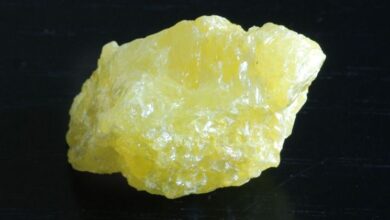Types of mealybugs

Mealybugs are, together with the spider mite, thrips and whitefly, one of the pests that most affect plants. They, like the others, love dry and warm environments; And not only that, but they usually appear when they perceive or detect some weakness. This does not mean otherwise that they are opportunists, and unfortunately if we do nothing they could end up drying up the crops.
But we believe that it is very necessary to identify the different types of mealybugs, since although it may be thought that they can be treated in the same way, each and every one of them has their favorite plants and when it comes to eliminating them we will need some products or others.
What are mealybugs?
The mealybugs are some insects that feed on plant sap. Specifically, they adhere to the underside of the leaves, often near the nerves, as well as to the petiole (stem, usually green although it can be other colors, which joins the leaf with the branch or trunk) if there is one.
These animals are small, since in their adult stage they usually do not exceed a centimeter in height or width. Their bodies are rounded or elongated, and most species have a black, brown or gray shell that protects them.
When are they most active?
They love the heat, so we will have to be a little vigilant during the driest and hottest season of the year. If we live in a temperate region, that will be the summer, although depending on the area it will not be too much to inspect the plants in spring and/ or autumn.
For example, where I live (Mallorca), both in April/ May and in September the maximum temperatures are high, exceeding 20ºC, and that is something that these insects love. In fact, it’s not uncommon for me to come across a cochineal cactus in early fall. Therefore, if the place where you live is hot, it is highly recommended to inspect your plants every day or every two days.
What are the most common types of mealybugs?
Plants can be affected by various pests, and if we talk about mealybugs, the most common are the following:
Ribbed mealybug ( Icerya purchasi )

Image – Flickr/ José María Escolano
The grooved mealybug is an insect similar to the cottony mealybug, but differs from it by having a reddish-brown shell that protects the body. It is oval in shape, and like all mealybugs, it can multiply in large numbers.
- Favorite plants: it is quite common in citrus (orange, lemon, mandarin, etc.).
- Symptoms: the fruits turn yellow and can spoil; affected leaves also lose color.
Cottony mealybug or cotonet ( Planococcus citri )

Image – Wikimedia/ Whitney Cranshaw
This is the easiest to identify. As its name suggests, the cottony mealybug has the appearance of a small, white cotton ball, and if pressed even gently it ‘breaks’. Their eggs are reddish-orange in color, and are protected by cottony silks.
- Favorite plants: in general all, but attacks more citrus, ornamental (including carnivorous) and conifers. It will only appear if the plant in question shows any sign of weakness, which may or may not be visible to humans; That is, you may be thirsty, hot, and/ or have some deficiency but have not yet manifested it externally.
- Symptoms: the leaves turn yellow and the fruits, if any, will fall off before ripening.
Red palm scale bug ( Phoenicococcus marlatii )
#gallery-1 {
margin: auto;
}
#gallery-1.gallery-item {
float: left;
margin-top: 10px;
text-align: center;
width: 50%;
}
#gallery-1 img {
border: 2px solid #cfcfcf;
}
#gallery-1.gallery-caption {
margin-left: 0;
}
/* see gallery_shortcode() in wp-includes/media.php */

Image – UF/ IFAS University of Florida

Image – Researchgate.net
If you have palm trees, you should know that they also «have» their own particular scale: the red scale. It goes through three stages (egg, nymph and adult), and has a red body. However, the female cannot move since her legs are atrophied, so to protect herself she secretes a white cottony liquid that becomes discolored.
- Favorite plants: palms and cicas.
- Symptoms: the leaves first turn yellow and then finish losing color, turning white. If the victim is a young specimen, without a trunk, it can cause death.
California red louse ( Aonidiella aurantii )

Image – Wikimedia/ VictorCegarra
The California red louse is a type of mealybug that looks nothing like the ones we’ve seen so far. It is rounded, almost flat, and is protected by a reddish shell.
- Favorite plants: citrus, palm trees and cacti, although it can affect others.
- Symptoms: yellowing of leaves and fruits, general weakening of the plant.
St. Joseph’s louse ( Aspidiotus perniciosus )

Image – Screenshot of Agrocentrochile.cl
The San José louse is similar to the previous one: the female is about 2 millimeters in diameter, which is protected by a shell, and always lives attached to the plant. The adult male has two wings.
- Favorite plants: it affects many species, but particularly fruit trees.
- Symptoms: the affected parts turn yellow, and may fall. In severe cases, the pest will dry out the plant.
How to eliminate mealybugs from plants?
The fundamental thing is to have them well cared for. This involves watering, and fertilizing whenever necessary (except for carnivorous plants, which do NOT have to be paid). But often, however well we think we take care of them, one day they may appear. For example, if you have cacti or other types of succulents, how many times have you seen a mealybug? Me a few times, every year. I have even seen them in carnivorous plants (sundew and sarracenia).
So what can be done to eliminate them? You can try any of these remedies:
- Remove them by hand. Well, whoever says by hand says with a brush, or a cloth (if you opt for this, soak them with water and a little soap). If the plant is small and the pest is not widespread, it is best.
- Spray the plant with distilled or rain water, and then sprinkle diatomaceous earth on top. This is a natural insecticide that will dehydrate the mealybugs, killing them. More information.
- Apply potassium soap. This is a natural product that will help protect the plant, eliminating the mealybugs that begin to exist. More information.
- Treat the plant with an anti-mealybug insecticide (on sale here ). We only advise this as a last option, and only if the plant is severely affected. You must follow the instructions on the container so that no problems arise. Also, you do NOT have to use chemical insecticides if the affected plant is a carnivore, as you could lose it.
- If you suspect that your plant, for example your cica, has mealybugs on the roots, instead of applying the product to the leaves, pour the dose indicated on the container in water and water.
Has this article helped you?




